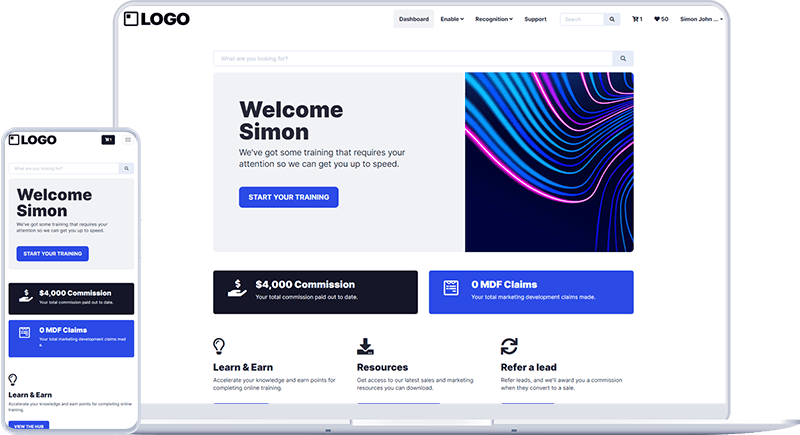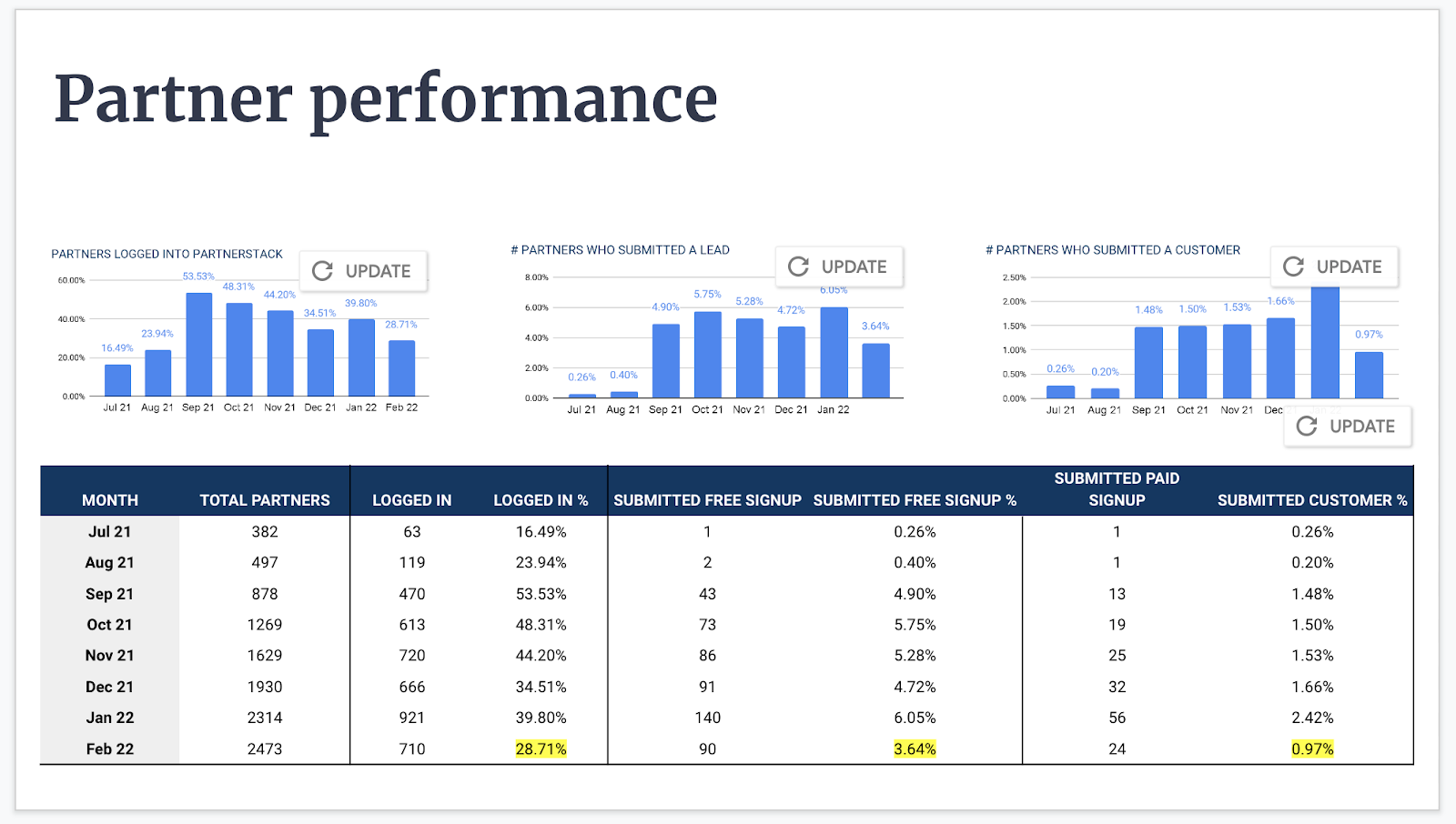NEW LIVE WEBINAR | May 14th :
11+ Strategies to Find & Recruit 1,000+ Affiliate Partners
Thank you! Your submission has been received!
Oops! Something went wrong while submitting the form.



So you’ve been tasked with running an affiliate program for your business?
Awesome.
But now you’re trying to decipher between these new acronyms and affiliate jargon, you’re unsure how to measure and optimize channel performance? Not so awesome.
Let’s fix that. We’ll share 17 affiliate marketing metrics and KPIs you need to track as an affiliate program manager. No BS and no fluff.
These are metrics you’ll use to build an affiliate reporting infrastructure so you can correctly and accurately measure the health of your program.


Businesses utilize quantitative measurements such as affiliate marketing metrics and KPIs (key performance indicators) to monitor the effectiveness of their affiliate marketing campaigns. The number of affiliate links clicked, the number of customers recommended by affiliates, and the total amount of money made from affiliate referrals are just a few examples of the various data points that may be included in these metrics and KPIs. Businesses may learn more about the efficacy of their affiliate marketing initiatives and make educated decisions about how to best optimize their campaigns by tracking these metrics and KPIs.
Below is an extensive list of affiliate metrics I’ve used over the years to track affiliate channel performance:
When you measure clicks (or page visits), you’re measuring the number of clicks attributed to your affiliate partner’s unique tracking link provided to them through your affiliate tracking software.
Measuring clicks is an essential metric because you’ll then be able to dive deeper into the quality of traffic by analyzing other sub-metrics such as; geographic location, top partners, time of day, pages, etc.

In its simplest form, signups are leads generated through your affiliate partner’s tracking URLs. They are not paying customers yet, but they may have subscribed to your newsletter, downloaded an ebook, or submitted a form for a coupon code on your site.
This is a great metric to pay attention to because you can then begin to measure funnel performance and timeline from lead to the customer compared to other marketing channels. Unlike other marketing channels, you’re typically not paying for the leads your affiliate marketers drive through your program (unless stated in the contract), so it’s a great way to build a low-cost demand funnel.

Like other marketing channels, this is arguably the most crucial metric for affiliate marketing. Measuring the number of conversions within a given day, week, month, or year can provide you with a holistic view of the overall health of your affiliate program.
If you’re having a down month in conversions from your program, you’ll then be able to reverse engineer the funnel and pinpoint precisely where the problem is; Partners testing new offers, seasonality, land page errors, etc. Conversions are the gut check of your affiliate program, and a metric you should always have top of mind when thinking about channel performance.
Conversion rate is a pretty straightforward metric, but hihgly impactful. To measure conversion rate, you take the number of conversions in a given period and divide by the number of page visits in that same period.
Conversions / landing page visits = conversion rate
When managing an affiliate program, your overall conversion rate can fluctuate quite a bit due to new affiliates recruited into your program, testing different traffic sources.

Examples:
Affiliate A)
For instance, you may have an affiliate that drives most of their traffic to your site through their blog and converts at 15%.
Affiliate B)
Whereas you may also have another affiliate that drives most of their traffic through pay-per-click campaigns and that traffic only converts at 5%.
Looking at a blended conversion rate is helpful, but it doesn’t tell the whole program picture.
New Revenue is precisely as it sounds… New revenue is generated from affiliate traffic. You’ll want to measure this number to see the new revenue coming in daily, weekly, monthly, and yearly from your affiliate partners' referral traffic.
Also, if you’re running different types of promotions with your partners throughout the year, you can then quickly identify which of these had the most impact on your business growth too.
New customers are customers who made their very first purchase with your brand. Keeping a pulse on this number allows you to also calculate other key metrics such as; Customer acquisition costs, retention, churn, etc.
If you’re a subscription-type business, this may be one of the most important metrics for you to look at on an ongoing basis with your affiliate team. Recurring revenue is a SaaS metric that measures the amount of money you make from your customers over some time.
The number can be calculated in several different ways, but it usually looks like this:
[monthly recurring revenue] = [monthly billing] * 12 / [average contract length]
Recurring revenue is often referred to as "sticky," because customers are usually less likely to leave the service than they are one-off purchases or subscriptions (like annual gym memberships).

The reversed sales rate measures how many customers purchase your product or service in a given time frame but then cancel their order. The reversed sales rate is most useful for understanding how many people are leaving your product in a given period, and what factors might be contributing to their departure.
In affiliate marketing, it’s also known as commission reversal because you will need to reverse your affiliate partner’s commission earned from previous canceled sales.
If you don’t have an automated way to check for reversals, you may run into issues with overpaying your affiliate partners, so pay close attention to this metric and what you’re paying your partners!
Average order value is a metric that measures the average amount of money customers spend on a single transaction. It's a valuable metric to look at when evaluating your affiliate marketing efforts because it tells you how much revenue is being generated from each customer, which can help you make decisions about future spending and growth.
Earnings per click, or EPC, is a metric that tells your affiliate partners how much money they make for every click they send on their affiliate link.
There are two ways to calculate EPC:
Pro tip: Affiliates LOVE this metric because it gives them an idea as to how much they can expect to earn from your program. Keep a close pulse on this number.
Tracking all of the commissions paid out to affiliate partners will give you a sense of your spending in a given period. You can then break this figure down by top partners paid out, type of partners, and commission growth over time.
Pro tip: If you can identify high-potential earning partners, we’d recommend a commission bump for these affiliates to continue incentivizing them. But, be sure it doesn’t cut too deep into your margins/CAC!
Partner outreach is the number of prospective partners you’ve reached out to in a given period to join your affiliate program.
Remember, your affiliate program will only be as successful as the quality and quantity of partners you recruit into your program, so be sure you’re building a recruiting pipeline. Check with your affiliate manager, consultant, or agency about affiliate recruitment efforts and how you can scale this up over time.

Like your initial affiliate outreach, you also want to track which partners joined your affiliate program! This will help you keep a pulse on partner growth over time, and the types of partners most interested in joining your program.
Pro Tip: Calculate your partner recruitment rate by dividing the total number of onboarded partners by total number of prospective partners reached out to in a given period.
Partners onboarded / partners reach out to = partner recruitment rate
Partner activity index measures how active your partners are within your affiliate program. It’s one thing to recruit partners into your program, but are they interested in promoting your products or services to their audience?
You can measure your partner activity index across several metrics:

We love to measure the types of partners who join your affiliate program because you can see which partners are most interested in your program and drive the most revenue for your program.
Here are a few different types of partners:
When you measure your top affiliate partners, you’re looking at partners who drive the most revenue, new customers, and traffic to your site.
Typically, we’ll see the top 20% of your affiliate partners drive almost 80% of total affiliate channel growth. This is why it’s so important to build close relationships with your top affiliate partners.
CAC by partner type is the measure of your customer acquisition cost by the type of partner. Because you will work with so many different partner types within your program, you will likely have other negotiated payout models.
When you have different payout models running across different partners, keep a close eye on the fluctuations in CAC across these partners – that way, you’re never overspending and continuing to build a healthy program.
To effectively use affiliate marketing metrics, businesses should regularly track and analyze the data to gain insights into the performance of their affiliate marketing efforts. This can be done using a variety of tools, such as affiliate marketing software or analytics platforms, which can provide detailed information about metrics such as click-through rate, conversion rate, average order value, and cost per acquisition.
Once the data has been collected, businesses can use it to identify trends and patterns in their affiliate marketing campaigns. For example, if the data shows that a particular affiliate is generating a high number of clicks but a low conversion rate, the business may need to adjust its marketing strategy to better target that affiliate's audience. Similarly, if the data shows that a particular product or service is generating a high average order value, the business may want to focus its efforts on promoting that product or service to affiliates.
By regularly tracking and analyzing affiliate marketing metrics, businesses can make informed decisions about how to optimize their campaigns for maximum success. This can help to drive more traffic to the business's website, increase sales, and ultimately generate more revenue through the affiliate marketing channel.
There are still many other metrics you can look at for the affiliate marketing channel, but these are some of our go-to metrics.
At the end of the day, it’ll depend on what’s most important to your business and the metrics that impact your organization's growth most.
Use these metrics to build a reporting infrastructure for your affiliate manager, keeping it updated and reviewed on a regular cadence so you can continue growing your channel.